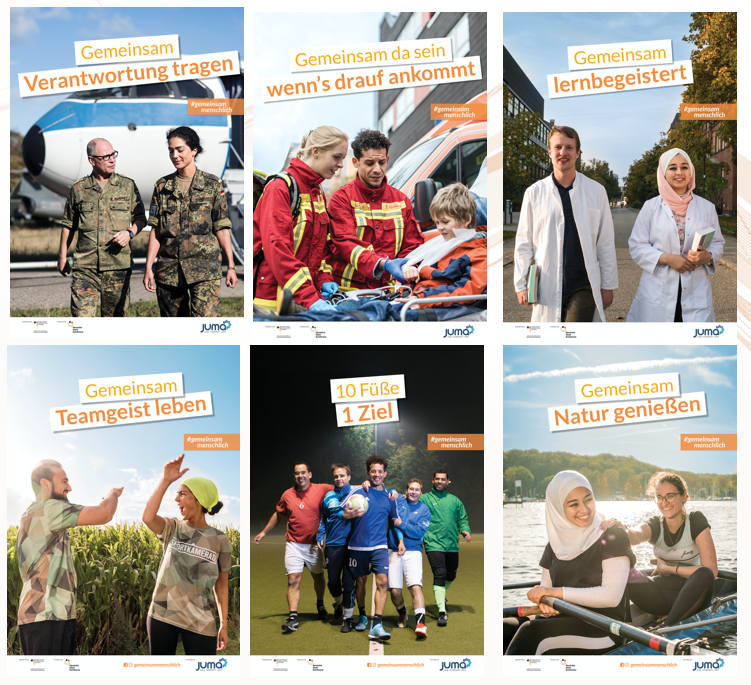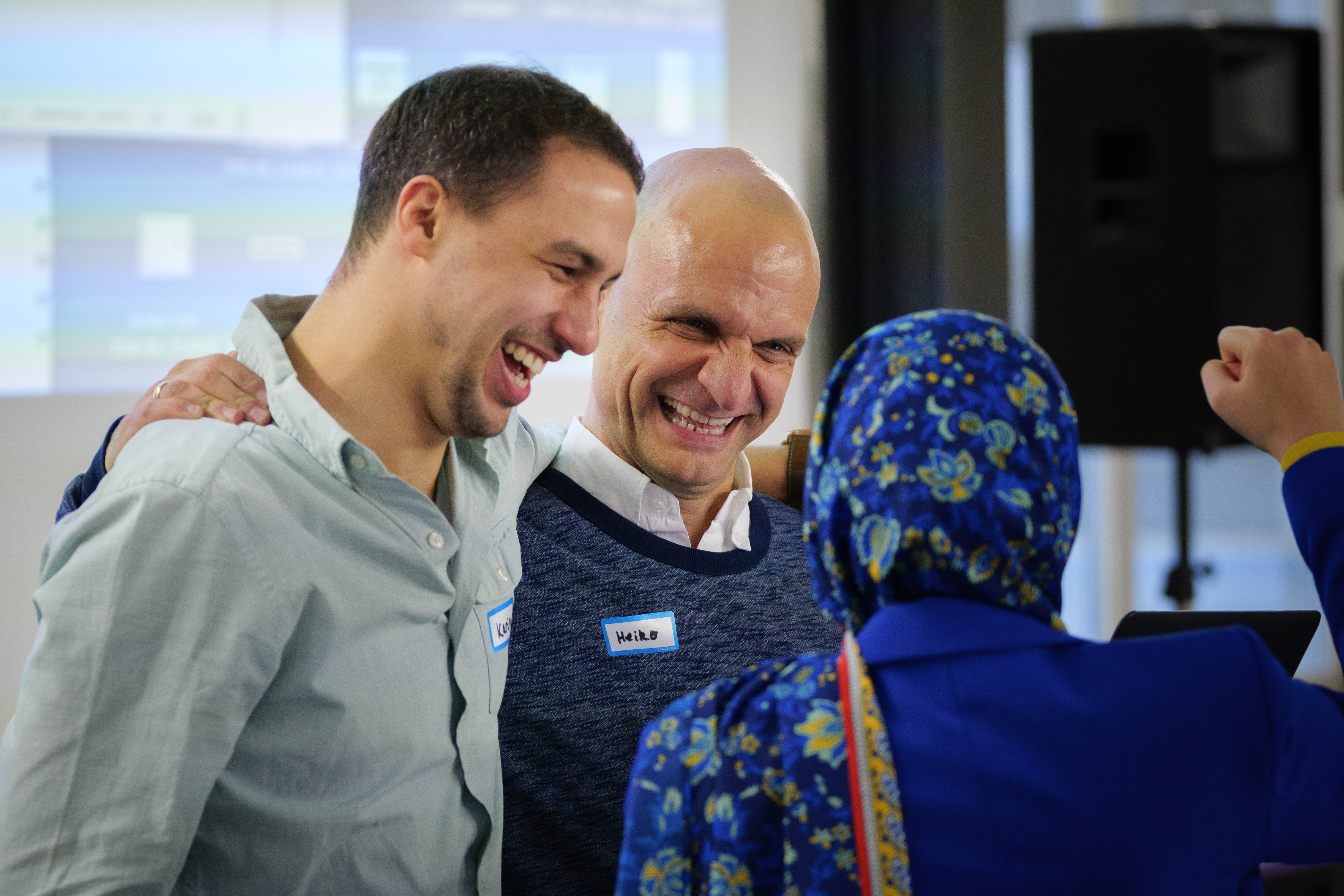Creative content development: Challenges & Solutions (by Nadia Wernli)
Back in December 2017, the first workshop of the Narrative Change Lab took place with the aim of reframing the migration debate in Germany. Since then, JUMA has been working together with ICPA on developing, refining and eventually building out the strategy for its “Together Human” campaign, which was finally launched at the end of 2019.
After the funding was secured and the timeline was set, the creative development team, made up of Karim El-Helaifi and myself, was put in charge of translating the ideas and values of the “Together Human” strategy into visuals that would resonate with our target group: ‘Economic Pragmatists’ from the movable middle in Germany.

In the following, I'll share the two main challenges we had to overcome and two pieces of advice based on our production process.
Challenge 1: Selecting the right creatives
Right from the start, we had a clear sense of what feeling the posters and videos should convey: warm, empathetic and genuine. In contrast to the traditional, non-emotional documentary style that typically focuses on the detailed representation of events, we were looking for videographers and photographers who would capture the sincere emotions of people engaged in a common activity. Such creatives are not easy to find, so we spent time reviewing portfolios and discussing options.
In the end, we found that creatives working in the field of event documentation (e.g. weddings, conferences) seemed more adept at the emotionally smart approach than creatives specialising in news and nature coverage.
Challenge 2: When reality clashes with strategy
Reaching the movable middle involves a specific approach, so sticking to the strategy is especially important, as Karim describes in his post. This can be particularly challenging during creative development, as sometimes the strategy seems to clash with the aesthetics of the content.
As soon as we started selecting the protagonists, we realised that some protagonists are perfect on paper, in terms of profession and values matching the strategy, but it was very challenging to portray them on posters. For instance, we explored engaging a fascinating woman who does poetry slam, but realised that images of her standing on a stage would be too generic and open to interpretation. We also had to work hard with one of our chosen protagonists, Nariman, the soldier, to depict the professional aspect of her life. Much of her job involves paperwork inside the office, which would not have made for interesting visuals, so we worked with Nariman to identify other real-life activities in her job which come across better in photos and video.
Another challenge during production was implementing our concept that protagonists should be portrayed together with their colleagues in their natural environment, preferably outdoors, to emphasise that they are part of a community. This was important to our strategy but the creatives often wanted to show the protagonists standing alone in portraits and in artificial settings that would “look good”. We had to work to move the conversation from pure aesthetics to strategy with aesthetics.

Image 2: The final 6 posters of the 3 protagonists in JUMA’s 'Together Human' campaign
I learned a lot from this process, so have some solutions to the challenges which I hope can serve as advice for others:
Tip 1: Learn when to compromise, and when not to
When you’re working with creatives, who usually have not been part of the campaign strategy development, there’s a high chance they will want to do things the traditional way. Trying something new might not always look aesthetically good which is why creatives may be reluctant to take the risk, especially with their reputation on the line. Like traditional media, creatives are used to focusing on ‘the drama’ and hence telling the story of ordinary lives in ways which tap into the values and emotions of the middle is a very new concept for them.
So, it’s important for you to know where to draw the line. For instance, while we agreed to have the protagonists and their colleagues interviewed indoors for sound quality, we insisted on shooting the photos for the posters outdoors, always with at least two people interacting. While giving feedback during the editing process and again following the campaign strategy, we also chose to de-emphasise the ‘dramatic parts’ that underline discrimination and exclusion and instead focus on the values that unite us.
Tip 2: If possible, have creative / design professionals as advisors
When collaborating with creative professionals, one can feel inhibited by one’s own limited knowledge and experience in the field. Here, it’s useful to have input from other creative professionals who also understand the narrative change approach. During the film shootings, the creatives would justify diverging from the campaign strategy on the basis that “it can’t be done otherwise”. As I work in design, I could tell that this was sometimes more due to risk aversion than real technical limits. In those tricky situations, we benefited from excellent input from Heiko, filmmaker and leader of the Creative Hub in ICPA’s Strategic Communications Incubator, who advised us on how to respond to those claims – identifying when they had merit and when we could negotiate or push the creatives to take a risk. We would then always review the results with Heiko afterwards to make sure that both strategy and aesthetics were in harmony. If you can get this kind of input during your creative development process, then I would highly recommend it!

Image 3: The JUMA creative development team (Nadia Wernli and Karim El-Helaifi) with Incubator Creative Hub advisor Heiko Kalmbach
After two and a half months, we reached our goal: six posters and six videos, offering a short and long version of each protagonist’s story. We were thrilled to see the positive results of the Swayable and Facebook A/B testing. The results proved that this new approach works and could be adopted by more campaigners working in the migration debate. It was such a rich experience with so many lessons to share and ideas to build on for future campaigns. We were already able to share our experiences with a campaign team from Kazakhstan and are looking forward to working with more campaigners aiming to reframe the migration debate.
About the author:
Nadia Wernli is a freelance multimedia designer and activist with a particular interest in helping social change organisations with their events and design outcomes, both conceptually as well as visually. At the time of the Narrative Change Lab, Nadia was a member of JUMA and co-led (with Karim El-Helaifi) the creative development of JUMA’s ‘Together Human’ campaign. She is a Narrative Change Associate, trained by ICPA to share the approach more widely.